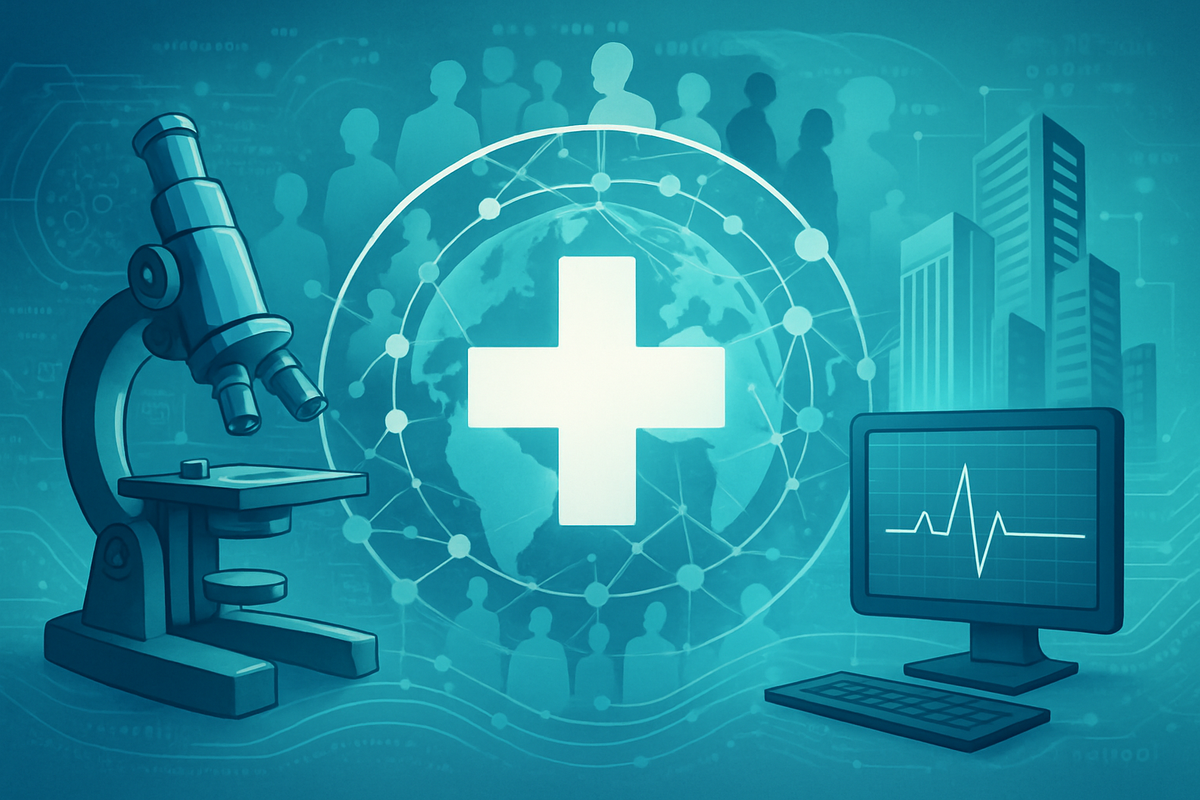
The global healthcare sector continues to assert its formidable influence on market momentum, demonstrating remarkable resilience and acting as a cornerstone for global indices. As of October 7, 2025, this vital industry is not merely adapting to change but is actively shaping the economic landscape through relentless innovation, strategic expansion, and a foundational response to universal human needs. Amidst fluctuating economic conditions and evolving technological frontiers, healthcare's intrinsic demand and continuous advancements position it as a critical driver of growth and a haven of stability for investors worldwide. Its defensive characteristics, coupled with an accelerating pace of technological integration, underscore its pivotal role in sustaining and propelling market performance.
This enduring strength is particularly evident through the performance of global behemoths with extensive international operations. These major players are at the forefront of driving innovation and expanding access to critical medical technologies and services, thereby contributing significantly to the sector's robust growth trajectory. Their strategic maneuvers and investment in cutting-edge research and development are not only enhancing patient outcomes but are also creating substantial economic value, solidifying the healthcare sector's position as a dominant force in the global financial markets.
Global Healthcare Giants Propel Sector Forward
The global healthcare sector's robust performance is significantly driven by major players with expansive global footprints, such as Thermo Fisher Scientific (NYSE: TMO). These companies are not just participants but architects of growth, leveraging their vast resources, innovative pipelines, and strategic market positioning to deliver consistent results and push the boundaries of medical science. Their operations span across diagnostics, life sciences research, laboratory products, and specialized medical equipment, addressing a wide spectrum of healthcare needs worldwide.
Thermo Fisher Scientific, for instance, exemplifies this trend through its comprehensive portfolio and strategic acquisitions. The company's commitment to research and development, particularly in areas like genomics, proteomics, and advanced analytical instruments, allows it to cater to the ever-increasing demand for precise diagnostics and groundbreaking scientific discoveries. Its global supply chain and manufacturing capabilities ensure that essential laboratory equipment, reagents, and services reach researchers and healthcare providers across continents, playing a critical role in both routine medical care and emergency responses, such as pandemic preparedness. The company's consistent investment in expanding its technological capabilities and market reach has cemented its position as a leader, driving both its own growth and contributing to the overall expansion of the life sciences and diagnostics segments of the healthcare market.
The timeline of events leading to the sector's current robust state includes a sustained period of increased investment in biotechnological research, accelerated digital transformation post-pandemic, and a growing global focus on preventive care and personalized medicine. Key players like Thermo Fisher have been instrumental in these shifts, rapidly developing and deploying solutions that meet these evolving demands. Initial market reactions to the sector's resilience have been largely positive, with investor confidence buoyed by strong earnings reports and the defensive nature of healthcare stocks, even as other sectors faced headwinds. The consistent demand for healthcare, irrespective of economic cycles, reinforces its appeal, leading to steady inflows into healthcare-focused funds and ETFs.
Moreover, the sector has benefited from a wave of mergers and acquisitions (M&A) activity, where larger companies strategically acquire innovative smaller firms to expand their product portfolios and technological capabilities. This consolidation not only fuels growth but also optimizes operational efficiencies and market reach. Regulatory bodies, while maintaining oversight, have also shown a willingness to fast-track approvals for critical innovations, particularly in areas of high unmet medical need, further accelerating the pace of development and market introduction for these key players.
Winners and Losers in a Dynamic Healthcare Landscape
The ongoing momentum within the global healthcare sector, spearheaded by giants like Thermo Fisher Scientific, creates a clear delineation of potential winners and losers across the industry ecosystem. Companies that are agile, innovation-driven, and possess strong intellectual property in high-growth areas are poised for significant gains, while those unable to adapt or compete on technological advancements may face challenges.
Potential Winners:
- Biotechnology and Pharmaceutical Innovators: Companies developing novel therapies, especially in areas like gene editing, RNA therapeutics, oncology, and rare diseases, stand to benefit immensely. Their ability to address unmet medical needs commands premium pricing and attracts significant investment. Firms with robust pipelines and successful clinical trials will see their valuations soar.
- Medical Device and Diagnostics Companies: Manufacturers of advanced medical devices, diagnostic tools, and laboratory equipment, particularly those integrating AI and digital health solutions, are well-positioned. Companies that can provide efficient, accurate, and cost-effective diagnostic solutions, like aspects of Thermo Fisher Scientific's portfolio, will experience increased demand.
- Digital Health and Telemedicine Providers: The accelerating adoption of digital health platforms, remote patient monitoring, and AI-powered healthcare analytics creates a fertile ground for growth. Companies offering scalable and secure digital solutions that improve patient access, reduce costs, and enhance care coordination will thrive.
- Contract Research Organizations (CROs) and Contract Development and Manufacturing Organizations (CDMOs): As pharmaceutical and biotech companies focus on R&D, they increasingly outsource clinical trials and manufacturing. CROs and CDMOs with specialized expertise and global capabilities will see a surge in demand for their services.
Potential Losers:
- Generic Drug Manufacturers with Limited Innovation: Companies solely focused on generic drugs without a strong pipeline of biosimilars or specialty generics may face margin compression due to intense competition and pricing pressures.
- Traditional Healthcare Providers Slow to Adopt Technology: Hospitals and clinics that lag in adopting digital health technologies, electronic health records, and AI-driven efficiencies may struggle with rising operational costs and diminished patient engagement.
- Companies with Outdated Product Portfolios: Firms heavily reliant on older technologies or therapies facing patent cliffs without new innovative products to replace them will likely experience declining revenues and market share.
- Small Biotech Firms Without Strategic Partnerships: While innovation is key, small biotech companies lacking the financial backing or strategic partnerships to navigate complex clinical trials and regulatory pathways may find it difficult to bring their products to market.
The ripple effect of major players' success is also evident in their supply chains. Suppliers of raw materials, specialized components, and advanced manufacturing technologies to companies like Thermo Fisher Scientific will likely see increased orders and stable business relationships. Conversely, competitors who cannot match the scale, efficiency, or innovation of these market leaders may find themselves losing market share and struggling to maintain profitability.
Wider Significance: A Resilient Anchor in Global Trends
The healthcare sector's sustained momentum transcends individual company performance, weaving into broader industry trends, influencing regulatory landscapes, and offering a historical testament to its enduring significance. This current surge is not an isolated event but rather a continuation and acceleration of long-term structural shifts.
One of the most significant broader industry trends is the demographic imperative of an aging global population. As lifespans extend, the prevalence of chronic diseases increases, driving an insatiable demand for advanced diagnostics, innovative therapies, and long-term care solutions. This demographic shift provides a fundamental, non-cyclical demand base that underpins the sector's resilience, making it less susceptible to economic downturns compared to discretionary consumer sectors. This trend is a multi-trillion-dollar market opportunity that healthcare companies are actively addressing through R&D and service expansion.
Furthermore, the digital transformation of healthcare is a pervasive trend. The integration of artificial intelligence (AI), machine learning, big data analytics, and telehealth solutions is revolutionizing how healthcare is delivered, managed, and researched. AI, for instance, is projected to be utilized in 90% of hospitals for early diagnosis and remote patient monitoring by the end of 2025, promising billions in annual savings and significantly improving diagnostic accuracy and operational efficiency. This technological leap not only enhances patient outcomes but also creates entirely new market segments and revenue streams for companies investing heavily in these areas.
Regulatory and policy implications are also crucial. While regulatory changes, such as the full implementation of the Inflation Reduction Act (IRA) in the U.S., can introduce short-term uncertainty, they often lead to long-term stability and predictability. For instance, capping Medicare Part D out-of-pocket costs is expected to stabilize demand for prescription drugs. Globally, governments are increasingly focused on healthcare infrastructure, pandemic preparedness, and equitable access, which translates into sustained public and private investment in the sector. These policy environments, while sometimes challenging, ultimately reinforce the essential nature of healthcare services.
Historically, the healthcare sector has often served as a defensive asset during periods of market volatility. Its ability to generate consistent revenues and profits, regardless of the broader economic climate, makes it an attractive investment during recessions or geopolitical uncertainties. This characteristic is particularly relevant in the current global economic environment, where inflation and interest rate fluctuations continue to be concerns. Comparisons to past economic downturns consistently show healthcare outperforming, providing a buffer against negative returns in broader portfolios and reducing overall volatility. The sector's strong earnings outlook for 2025, potentially the highest in 18 years (excluding the COVID-19 period), further underscores its current robust position within the global market.
What Comes Next: Navigating a Future of Innovation and Integration
The trajectory of the global healthcare sector points towards a future defined by accelerated innovation, deeper technological integration, and a strategic focus on value-based care. Both short-term adaptations and long-term strategic pivots will be crucial for companies aiming to capitalize on emerging opportunities and mitigate potential challenges.
In the short-term, we can expect a continued emphasis on digital health solutions, particularly in areas like remote monitoring, telehealth expansion, and AI-driven diagnostics. Companies that can swiftly deploy and scale these technologies will gain a competitive edge. There will also be a sustained focus on addressing immediate public health needs, including infectious diseases and chronic condition management, driving demand for new vaccines, therapies, and preventative care models. Market opportunities will arise from targeted investments in specific therapeutic areas, such as obesity and Alzheimer's disease, where significant breakthroughs are anticipated.
Looking long-term, the healthcare landscape will likely be characterized by a more integrated and personalized approach to medicine. Genomic medicine, advanced cell and gene therapies, and precision diagnostics will become increasingly mainstream. This will necessitate significant strategic pivots for pharmaceutical and biotech companies, requiring them to invest heavily in R&D for these complex modalities and adapt their manufacturing and distribution networks. The shift towards value-based care models is expected to become predominant, moving away from fee-for-service. This will challenge traditional business models and reward providers and innovators who can demonstrate superior patient outcomes and cost-effectiveness.
Market opportunities will emerge in several key areas: the development of AI-powered drug discovery platforms, advanced robotic surgery systems, and innovative solutions for mental and behavioral health integration. Furthermore, the burgeoning healthcare markets in emerging economies will present substantial growth avenues for companies capable of tailoring their products and services to diverse local needs and regulatory environments. However, challenges will include navigating increasingly complex regulatory frameworks, managing rising healthcare costs, and addressing cybersecurity threats to protect sensitive patient data.
Potential scenarios include a continued upward trajectory for the sector, driven by technological breakthroughs and demographic tailwinds, leading to sustained outperformance in global indices. Alternatively, unforeseen global health crises or significant shifts in regulatory policy could introduce volatility, though the sector's inherent resilience suggests it would likely adapt and recover. The overall outcome points towards a healthcare ecosystem that is more efficient, personalized, and globally interconnected, driven by continuous innovation and strategic collaboration.
A Resilient Force: Summarizing Healthcare's Lasting Impact
The global healthcare sector stands as an undeniable powerhouse, profoundly influencing market momentum and serving as a crucial anchor for global indices. Its current robust performance, exemplified by the consistent growth and innovation from global players like Thermo Fisher Scientific (NYSE: TMO), underscores its intrinsic value and strategic importance in the global economy. The sector's resilience is not accidental but is built upon fundamental drivers: an aging global population, relentless technological advancements, rising healthcare expenditure, and a continuous pipeline of life-changing innovations.
Key takeaways from this analysis highlight the sector's defensive qualities, offering stability during economic uncertainties, and its consistent ability to generate strong earnings. The pervasive digital transformation, with AI and telehealth at its core, is not just improving patient care but also creating vast economic efficiencies and new market segments. The shift towards value-based care and personalized medicine further solidifies the sector's long-term growth prospects, as it aligns economic incentives with improved patient outcomes.
Moving forward, the market will continue to be shaped by these powerful trends. Investors should watch for companies that are leaders in innovation, particularly in areas like advanced diagnostics, gene therapies, and digital health solutions. The ongoing M&A activity within the sector will also be a key indicator of strategic consolidation and growth areas. Furthermore, monitoring regulatory developments, especially those impacting drug pricing and market access, will be crucial for understanding potential shifts in the operating environment.
In conclusion, the global healthcare sector is more than just a collection of companies; it is a dynamic, evolving ecosystem that is vital to human well-being and a powerful engine for economic growth. Its lasting impact will be defined by its ability to continue innovating, adapting to global needs, and consistently delivering value, making it an indispensable component of any well-diversified investment portfolio in the years to come.
This content is intended for informational purposes only and is not financial advice.







